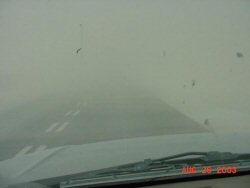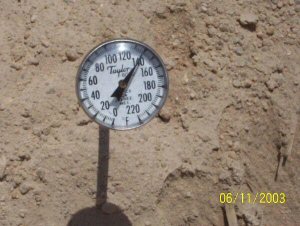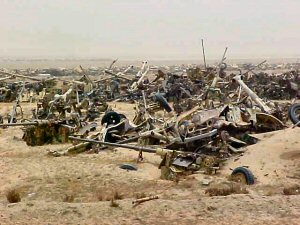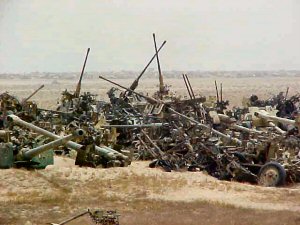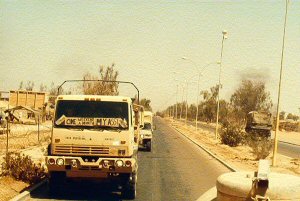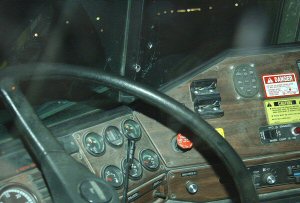Ed Note: Jim has recently returned from Iraq and has graciously answered every question I put before him.
Q. How did you feel when you found out that you were going? A. I was very excited! This was my first deployment to war, even though I’ve been in the military (active duty USMC and Army National Guard) for 26 years. Unless you’ve been personally challenged to your limits, you have no clue how you’re liable to act during moments of stress, fatigue and chaos. This was the opportunity to find out if I was going to fold (morally, emotionally, physically) or keep on going. Q. How did you get there? A. On May 15th, 2003 my Army National Guard unit, the 111th Engineer Group, boarded a chartered DC-10 in Indianapolis, IN. We flew the first leg of our trip to Cyprus, where we sat in the plane for 3 hours during aircraft servicing. Then it was on to Kuwait City International Airport, where we arrived at 1am. The total flight lasted 14 hours, and we found ourselves in a time zone 8 hours ahead of West Virginia. Q. Did you meet any of the local people, what were they like? A. I had a chance to meet several merchants and ordinary folks in both Kuwait and Iraq. I have to say, to a one they were cordial and friendly. The American news services portray all Iraqis as disgusted with, and wishing to fight against all Coalition Forces, and the United States in particular. I can personally say that those I had the opportunity to talk with (sometimes you had to communicate via sign language), or wave and smile to were generally very nice. Some were reluctant to show their feelings, and you never initiated a conversation with a lady. Some of the guys discovered that the friendly smiles quickly disappeared if they tried to talk to the younger women. There was a clear line of decorum, and as if you contemplated touching a clearly marked hi-voltage fence. Q. Did you get a chance to eat any of the local food, what was it like? A. There were several delicacies which we tried. Some were less than palatable (an unknown green substance), while others were so sweet we knew sugar shock must be close by. Q. Were you ever scared? A. I wasn't ever scared, but very edgy for the first day and a half after we landed and were housed at Camp Wolf - a sort of holding-camp for newly arrived personnel. The fear of the unknown is simply awful, and we suffered the fear that we were somehow unprepared for what really lay ahead. The bus trip to Camp Arifjan, Kuwait, was pretty tense, as heavy window curtains blocked some of the sun's heat and allowed us to peek out at the new environment. We passed Mercedes and Volvo cars and trucks, and the ubiquitous white Toyota and Nissan pickup which we later found to be a favored terrorist ambush vehicle (there are LOTs of them around), and imagined there was a threat in every furtive glance. Q. What was the strangest thing you saw? A. Desiccated 2-foot long lizards. There were live ones, of course, that lived in hollowed-out dens in the dirt, but we occasionally encountered those that never quite found enough prey to sustain their moisture requirements. The first mummified lizard I saw was mounted as a hood ornament on a 2 1/2 ton army truck. Q. What did you miss the most? A. Green foliage. Everything was tan, except for the occasional shrub or scrub tree. When I returned to the United States, I couldn't get enough of the simple fragrance of trees and grass, and would frequently sit in my back yard, absorbing the sights and sounds of America. Q. What was the most enjoyable thing you did? A. Get two extra hours of sleep on Sunday morning, after the shift hours were eventually relaxed. Initially, the shifts were 12 hours on, 12 hours off, 7 days per week. As the work pace stabilized, most of the troops in our command were permitted a day off, generally on Saturday or Sunday. Q. Is the desert in Iraq similar to what we have out West? A. The variations in terrain were remarkable, going from table-top flat from horizon to horizon sand to scrub brush to what you would normally see in the open-range area of Wyoming or Idaho. The sand consistency differed greatly from Kuwait to Iraq as well, Iraq's being noticeably coarser with more shades of light and dark. Q. How did you and your equipment do in extreme heat or other weather conditions? A. Our equipment held up pretty well, even in the extreme heat. We expected the occasional engine cooling problems, and key areas became too hot to touch unless protected (such as steering wheels). Lessons learned included keeping a watchful eye on air filtration systems and doing complete systems checks before moving your vehicle. Sandstorms took their toll on canvas vehicle covers, and there is no wooden tent stake in existence that will penetrate the concrete-like hardpan beneath the sandy surface of most places we stayed. It didn't take me long to discover the intended use for the 12" rebar we saw laying about. Ed Note: here are a few of the photos that Jim sent me earlier. In addition to these, I'll have an entire photo essay put together from photos that he is willing to share with us soon. The photo of the windshield is pretty large but it is also very impressive. The photo titled recruiting sign has a humorous sign in the window.
An interesting E-mail written by Jim Heikkinen… while serving in Iraq. |
 Frogtails, Faces you remember
Frogtails, Faces you remember
